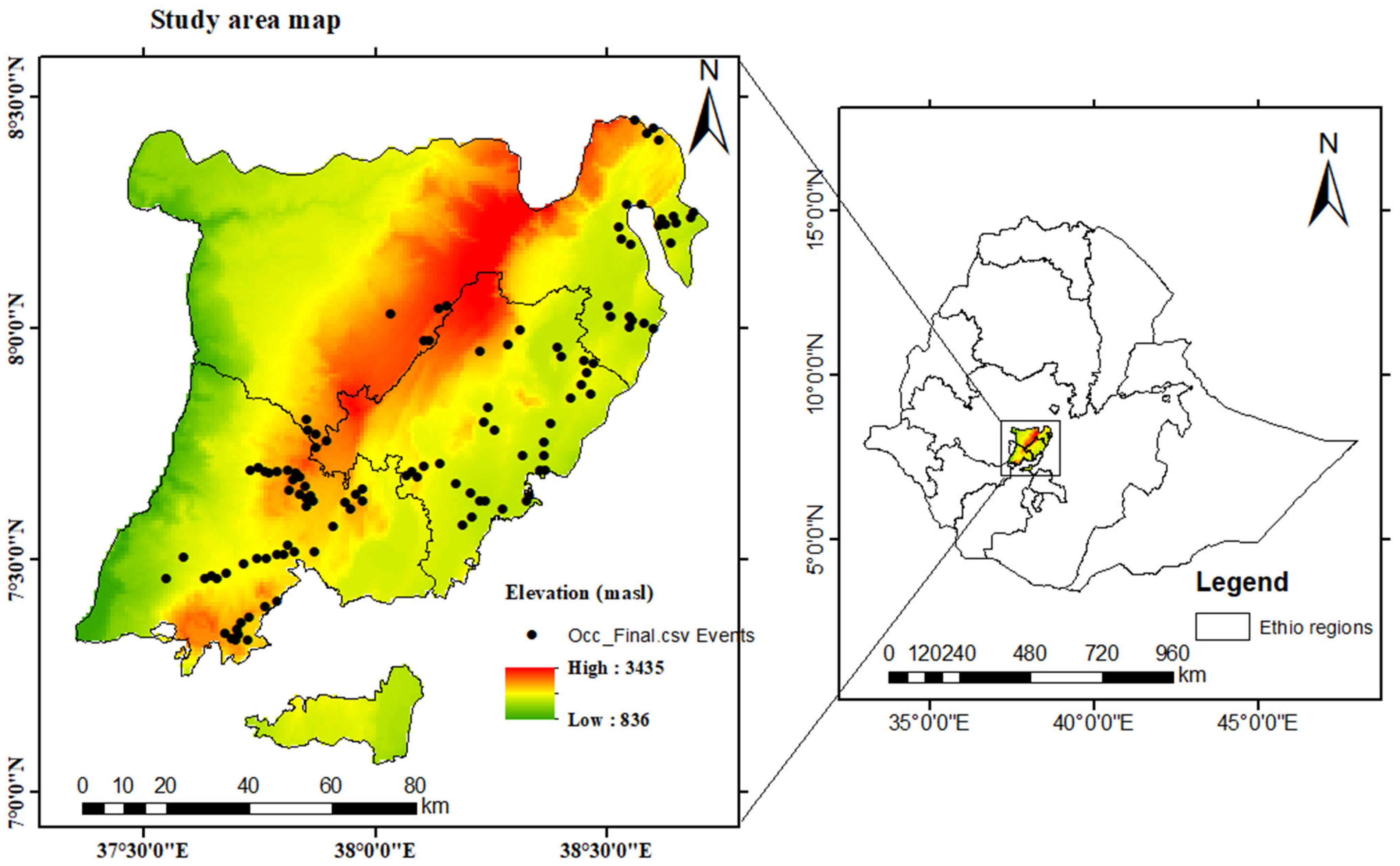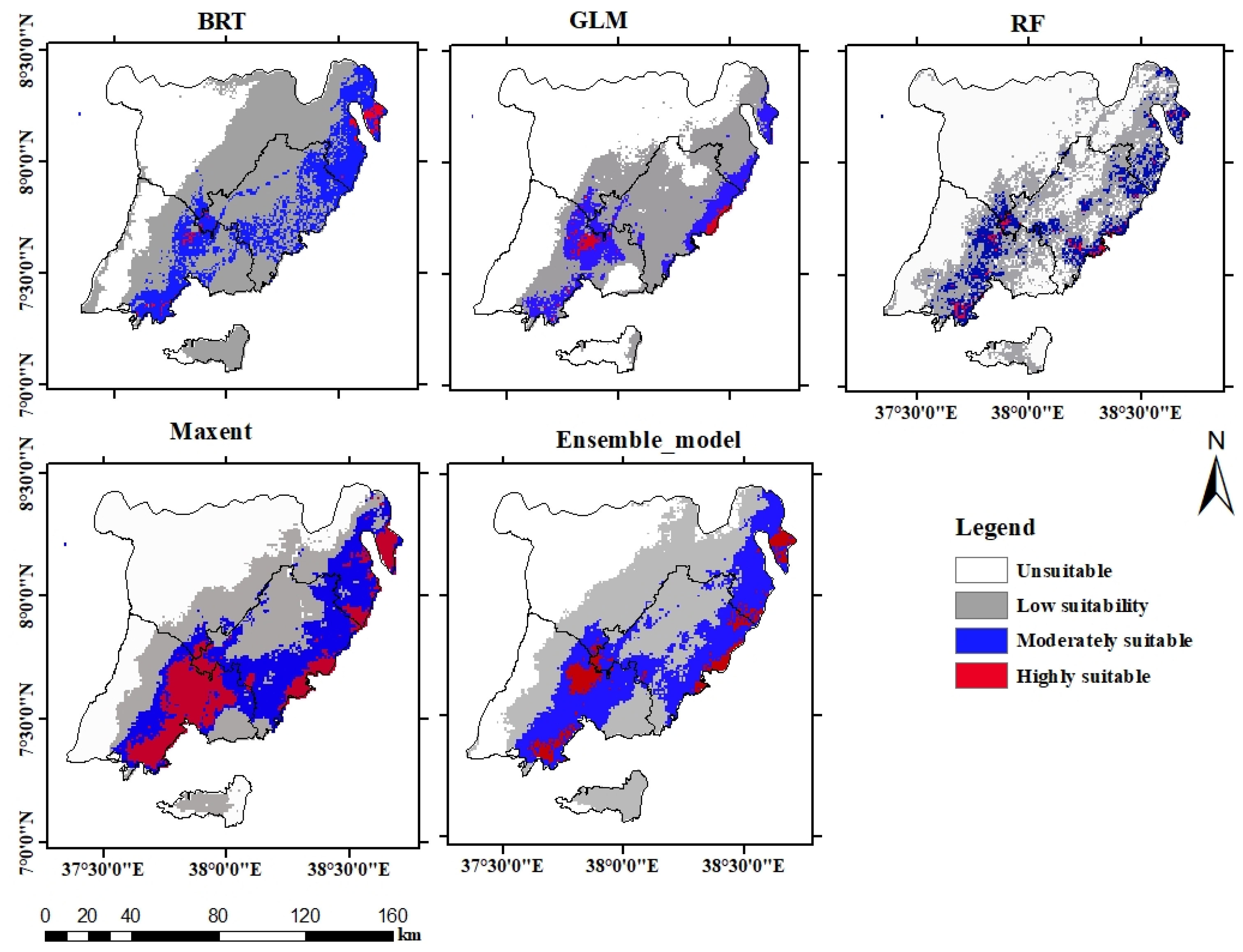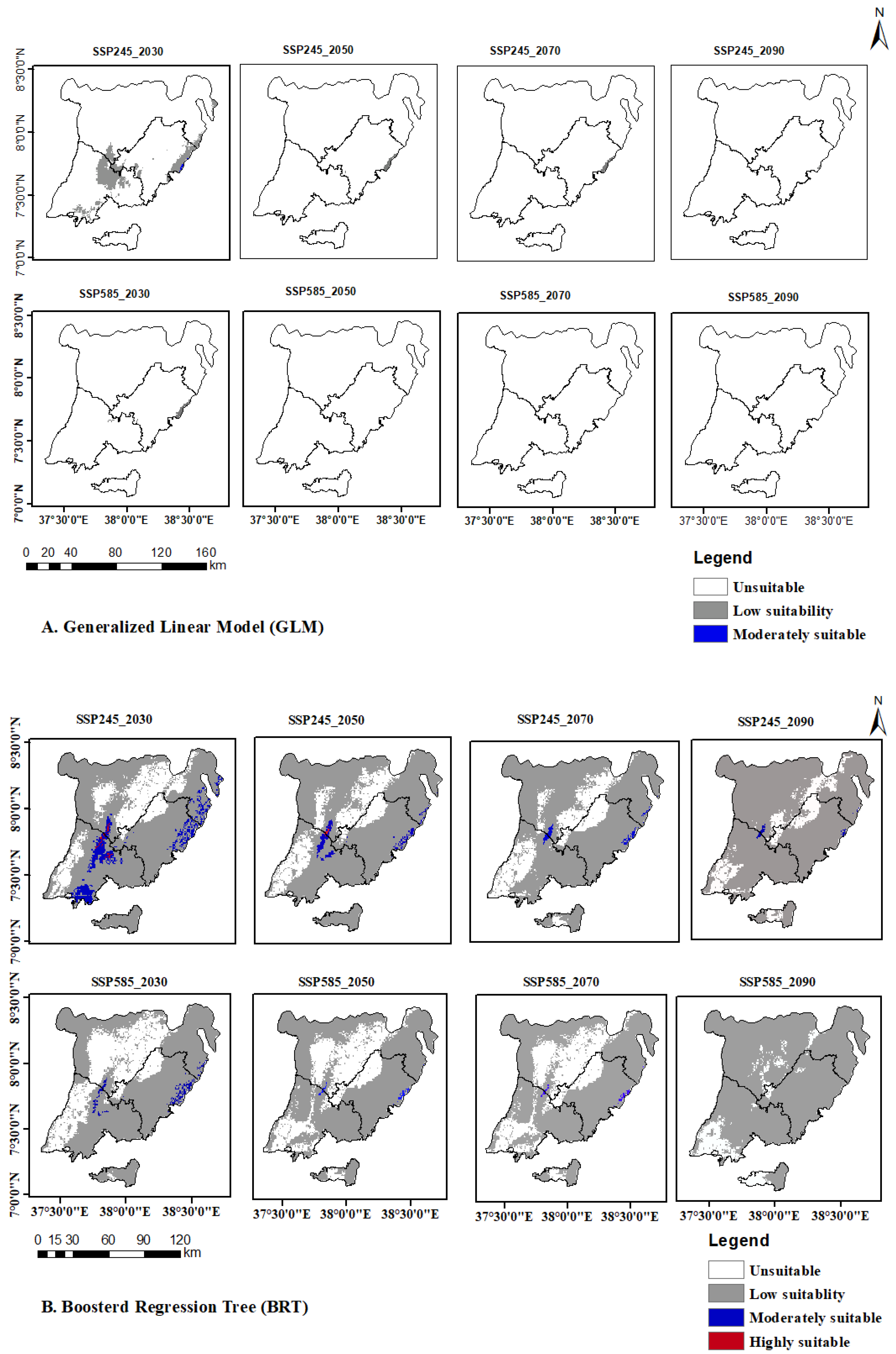Unveiling Wheat’s Future Amidst Climate Change in the Central Ethiopia Region
Abstract
:1. Introduction
2. Materials and Methods
2.1. Study Area Description
2.2. Species Occurrence Points or Sample Location Data
2.3. Environmental Variables
2.4. Variable Importance and Collinearity Test for Variable Selection
2.5. Modelling Algorithms
2.5.1. Maxent Model
2.5.2. Random Forest
2.5.3. Boosted Regression Trees
2.5.4. Generalised Linear Model
2.5.5. Ensemble Model
2.6. Evaluation of Model Performance
3. Results and Discussions
3.1. Model Fitting and Performance
3.2. Contribution of Environmental Variables Affecting Wheat Cultivation in CER
3.3. Current Climate Suitability of Wheat in the CER
3.4. Wheat Habitat Suitability under Future Climate Scenarios
3.5. Limitations of the Study
4. Conclusions and Future Directions
Author Contributions
Funding
Institutional Review Board Statement
Data Availability Statement
Acknowledgments
Conflicts of Interest
References
- Devereux, S.; Edwards, J. Climate change and food security. IDS Bull. 2004, 35, 22–30. [Google Scholar] [CrossRef]
- Luo, Y.; Su, B.; Currie, W.S.; Dukes, J.S.; Finzi, A.; Hartwig, U.; Hungate, B.; McMurtrie, R.E.; Oren, R.; Parton, W.J. Progressive nitrogen limitation of ecosystem responses to rising atmospheric carbon dioxide. Bioscience 2004, 54, 731–739. [Google Scholar] [CrossRef]
- Tai, A.P.; Martin, M.V.; Heald, C.L. Threat to future global food security from climate change and ozone air pollution. Nat. Clim. Change 2014, 4, 817–821. [Google Scholar] [CrossRef]
- Islam, M.T.; Nursey-Bray, M. Adaptation to climate change in agriculture in Bangladesh: The role of formal institutions. J. Environ. Manag. 2017, 200, 347–358. [Google Scholar] [CrossRef] [PubMed]
- Stocker, T.; Qin, D.; Plattner, G.-K.; Tignor, M.; Allen, S.; Boschung, J.; Nauels, A.; Xia, Y.; Bex, V.; Midgley, P. Summary for Policymakers; Cambridge University Press: Cambridge, UK; New York, NY, USA, 2014. [Google Scholar]
- Asseng, S.; Ewert, F.; Martre, P.; Rötter, R.P.; Lobell, D.B.; Cammarano, D.; Kimball, B.A.; Ottman, M.J.; Wall, G.; White, J.W. Rising temperatures reduce global wheat production. Nat. Clim. Change 2015, 5, 143–147. [Google Scholar] [CrossRef]
- Asseng, S.; Foster, I.; Turner, N.C. The impact of temperature variability on wheat yields. Glob. Change Biol. 2011, 17, 997–1012. [Google Scholar] [CrossRef]
- Gao, Y.; Zhang, A.; Yue, Y.; Wang, J.A.; Su, P. Predicting Shifts in Land Suitability for Maize Cultivation Worldwide Due to Climate Change: A Modelling Approach. Land 2021, 10, 295. [Google Scholar] [CrossRef]
- Gong, L.; Li, X.; Wu, S.; Jiang, L. Prediction of potential distribution of soybean in the frigid region in China with MaxEnt modelling. Ecol. Inform. 2022, 72, 101834. [Google Scholar] [CrossRef]
- Vitasse, Y.; Signarbieux, C.; Fu, Y.H. Global warming leads to more uniform spring phenology across elevations. Proc. Natl. Acad. Sci. USA 2018, 115, 1004–1008. [Google Scholar] [CrossRef]
- Fodor, N.; Challinor, A.; Droutsas, I.; Ramirez-Villegas, J.; Zabel, F.; Koehler, A.-K.; Foyer, C.H. Integrating plant science and crop modelling: Assessment of the impact of climate change on soybean and maize production. Plant Cell Physiol. 2017, 58, 1833–1847. [Google Scholar] [CrossRef]
- Elith, J.; Kearney, M.; Phillips, S. The art of modelling range-shifting species. Methods Ecol. Evol. 2010, 1, 330–342. [Google Scholar] [CrossRef]
- Gregory, P.J.; Ingram, J.S.; Brklacich, M. Climate change and food security. Philos. Trans. R. Soc. B Biol. Sci. 2005, 360, 2139–2148. [Google Scholar] [CrossRef] [PubMed]
- Naimi, B.; Araújo, M.B. sdm: A reproducible and extensible R platform for species distribution modelling. Ecography 2016, 39, 368–375. [Google Scholar] [CrossRef]
- Shabani, F.; Kumar, L.; Ahmadi, M. A comparison of absolute performance of different correlative and mechanistic species distribution models in an independent area. Ecol. Evol. 2016, 6, 5973–5986. [Google Scholar] [CrossRef] [PubMed]
- Ahmad, R.; Khuroo, A.A.; Charles, B.; Hamid, M.; Rashid, I.; Aravind, N. Global distribution modelling, invasion risk assessment and niche dynamics of Leucanthemum vulgare (Ox-eye Daisy) under climate change. Sci. Rep. 2019, 9, 11395. [Google Scholar] [CrossRef] [PubMed]
- Khan, S.; Verma, S. Ensemble modelling to predict the impact of future climate change on the global distribution of Olea europaea subsp. cuspidata. Front. For. Glob. Change 2022, 5, 977691. [Google Scholar] [CrossRef]
- FAOSTAT. Crops and Livestock Products. 2022. Available online: https://www.fao.org/faostat/en/ (accessed on 25 July 2024).
- Senbeta, A.F.; Worku, W. Ethiopia’s wheat production pathways to self-sufficiency through land area expansion, irrigation advance, and yield gap closure. Heliyon 2023, 9, e20720. [Google Scholar] [CrossRef] [PubMed]
- Effa, K.; Fana, D.M.; Nigussie, M.; Geleti, D.; Abebe, N.; Dechassa, N.; Anchala, C.; Gemechu, G.; Bogale, T.; Girma, D. The irrigated wheat initiative of Ethiopia: A new paradigm emulating Asia’s green revolution in Africa. Environ. Dev. Sustain. 2023, 1–26. [Google Scholar] [CrossRef]
- Wilson, R.J.; Gutiérrez, D.; Gutiérrez, J.; Martínez, D.; Agudo, R.; Monserrat, V.J. Changes to the elevational limits and extent of species ranges associated with climate change. Ecol. Lett. 2005, 8, 1138–1146. [Google Scholar] [CrossRef] [PubMed]
- Evangelista, P.; Young, N.; Burnett, J. How will climate change spatially affect agriculture production in Ethiopia? Case studies of important cereal crops. Clim. Change 2013, 119, 855–873. [Google Scholar] [CrossRef]
- CSA. Agricultural Sample Survey 2020/2021 (2013 E.C) (September–December 2020). Report on Farm Manage Democraticices (Private Peasant Holdings, Meher Season); The Federal Democratic Republic of Ethiopia, Central Statistical Agency Addis Ababa: Addis Ababa, Ethiopia, 2020. [Google Scholar]
- Fick, S.E.; Hijmans, R.J. WorldClim 2: New 1-km spatial resolution climate surfaces for global land areas. Int. J. Climatol. 2017, 37, 4302–4315. [Google Scholar] [CrossRef]
- O’Neill, B.C.; Kriegler, E.; Riahi, K.; Ebi, K.L.; Hallegatte, S.; Carter, T.R.; Mathur, R.; Van Vuuren, D.P. A new scenario framework for climate change research: The concept of shared socioeconomic pathways. Clim. Change 2014, 122, 387–400. [Google Scholar] [CrossRef]
- Naimi, B.; Hamm, N.A.; Groen, T.A.; Skidmore, A.K.; Toxopeus, A.G. Where is positional uncertainty a problem for species distribution modelling? Ecography 2014, 37, 191–203. [Google Scholar] [CrossRef]
- Naimi, B.; Capinha, C.; Ribeiro, J.; Rahbek, C.; Strubbe, D.; Reino, L.; Araújo, M.B. Potential for invasion of traded birds under climate and land-cover change. Glob. Change Biol. 2022, 28, 5654–5666. [Google Scholar] [CrossRef] [PubMed]
- Phillips, S.J.; Anderson, R.P.; Schapire, R.E. Maximum entropy modelling of species geographic distributions. Ecol. Model. 2006, 190, 231–259. [Google Scholar] [CrossRef]
- Breiman, L. Random forests. Mach. Learn. 2001, 45, 5–32. [Google Scholar] [CrossRef]
- Elith, J.; Leathwick, J.R.; Hastie, T. A working guide to boosted regression trees. J. Anim. Ecol. 2008, 77, 802–813. [Google Scholar] [CrossRef] [PubMed]
- McCullagh, P.; Nelder, J.A. Binary data. In Generalized Linear Models; Springer: Berlin/Heidelberg, Germany, 1989; pp. 98–148. [Google Scholar]
- Hannah, L.; Ikegami, M.; Hole, D.G.; Seo, C.; Butchart, S.H.; Peterson, A.T.; Roehrdanz, P.R. Global climate change adaptation priorities for biodiversity and food security. PLoS ONE 2013, 8, e72590. [Google Scholar] [CrossRef] [PubMed]
- Akpoti, K.; Higginbottom, T.P.; Foster, T.; Adhikari, R.; Zwart, S.J. Mapping land suitability for informal, small-scale irrigation development using spatial modelling and machine learning in the Upper East Region, Ghana. Sci. Total Environ. 2022, 803, 149959. [Google Scholar] [CrossRef] [PubMed]
- Fourcade, Y. Comparing species distributions modelled from occurrence data and from expert-based range maps. Implication for predicting range shifts with climate change. Ecol. Inform. 2016, 36, 8–14. [Google Scholar] [CrossRef]
- Kaky, E.; Nolan, V.; Alatawi, A.; Gilbert, F. A comparison between Ensemble and MaxEnt species distribution modelling approaches for conservation: A case study with Egyptian medicinal plants. Ecol. Inform. 2020, 60, 101150. [Google Scholar] [CrossRef]
- Li, X.; Wang, Y. Applying various algorithms for species distribution modelling. Integr. Zool. 2013, 8, 124–135. [Google Scholar] [CrossRef] [PubMed]
- Leathwick, J.; Elith, J.; Francis, M.; Hastie, T.; Taylor, P. Variation in demersal fish species richness in the oceans surrounding New Zealand: An analysis using boosted regression trees. Mar. Ecol. Prog. Ser. 2006, 321, 267–281. [Google Scholar] [CrossRef]
- Catalano, G.A.; D’Urso, P.R.; Maci, F.; Arcidiacono, C. Influence of Parameters in SDM Application on Citrus Presence in Mediterranean Area. Sustainability 2023, 15, 7656. [Google Scholar] [CrossRef]
- Grimmett, L.; Whitsed, R.; Horta, A. Presence-only species distribution models are sensitive to sample prevalence: Evaluating models using spatial prediction stability and accuracy metrics. Ecol. Model. 2020, 431, 109194. [Google Scholar] [CrossRef]
- Phillips, S.J.; Anderson, R.P.; Dudík, M.; Schapire, R.E.; Blair, M.E. Opening the black box: An open-source release of Maxent. Ecography 2017, 40, 887–893. [Google Scholar] [CrossRef]
- Duan, R.-Y.; Kong, X.-Q.; Huang, M.-Y.; Fan, W.-Y.; Wang, Z.-G. The predictive performance and stability of six species distribution models. PLoS ONE 2014, 9, e112764. [Google Scholar] [CrossRef] [PubMed]
- Allouche, O.; Tsoar, A.; Kadmon, R. Assessing the accuracy of species distribution models: Prevalence, kappa and the true skill statistic (TSS). J. Appl. Ecol. 2006, 43, 1223–1232. [Google Scholar] [CrossRef]
- Yackulic, C.B.; Chandler, R.; Zipkin, E.F.; Royle, J.A.; Nichols, J.D.; Campbell Grant, E.H.; Veran, S. Presence-only modelling using MAXENT: When can we trust the inferences? Methods Ecol. Evol. 2013, 4, 236–243. [Google Scholar] [CrossRef]
- Jing-Song, S.; Guang-Sheng, Z.; Xing-Hua, S. Climatic suitability of the distribution of the winter wheat cultivation zone in China. Eur. J. Agron. 2012, 43, 77–86. [Google Scholar] [CrossRef]
- Shabani, F.; Kumar, L.; Solhjouy-Fard, S. Variances in the projections, resulting from CLIMEX, Boosted Regression Trees and Random Forests techniques. Theor. Appl. Climatol. 2017, 129, 801–814. [Google Scholar] [CrossRef]
- Elith, J.; Graham, C.H.; Anderson, R.P.; Dudík, M.; Ferrier, S.; Guisan, A.; Hijmans, R.J.; Huettmann, F.; Leathwick, J.R.; Lehmann, A. Novel methods improve prediction of species’ distributions from occurrence data. Ecography 2006, 29, 129–151. [Google Scholar] [CrossRef]
- West, A.M.; Evangelista, P.H.; Jarnevich, C.S.; Young, N.E.; Stohlgren, T.J.; Talbert, C.; Talbert, M.; Morisette, J.; Anderson, R. Integrating remote sensing with species distribution models; mapping tamarisk invasions using the software for assisted habitat modelling (SAHM). JoVE (J. Vis. Exp.) 2016, 116, e54578. [Google Scholar] [CrossRef]
- Yang, M.; Wang, G.; Ahmed, K.F.; Adugna, B.; Eggen, M.; Atsbeha, E.; You, L.; Koo, J.; Anagnostou, E. The role of climate in the trend and variability of Ethiopia’s cereal crop yields. Sci. Total Environ. 2020, 723, 137893. [Google Scholar] [CrossRef] [PubMed]
- Gebresamuel, G.; Abrha, H.; Hagos, H.; Elias, E.; Haile, M. Empirical modelling of the impact of climate change on altitudinal shift of major cereal crops in South Tigray, Northern Ethiopia. J. Crop Improv. 2021, 36, 169–192. [Google Scholar] [CrossRef]
- White, J.W.; Tanner, D.G.; Corbett, J.D. An Agro-Climatological Characterization of Bread Wheat Production Areas in Ethiopia. 2001. Available online: http://hdl.handle.net/10883/1022 (accessed on 21 March 2024).
- Gebre-Mariam, H.; Tanner, D.G.; Hulluka, M. Wheat Research in Ethiopia: A Historical Perspective; Institute of Agricultural Research: New Delhi, India, 1991. [Google Scholar]








| Code | Name | Units |
|---|---|---|
| Bio1 | Annual Mean Temperature | °C |
| Bio2 | Mean Diurnal Range (Mean of monthly (max temp–min temp)) | °C |
| Bio3 | Isothermality (Bio2/Bio7) (×100) | - |
| Bio4 | Temperature Seasonality (standard deviation ×100) | °C |
| Bio5 | Max Temperature of Warmest Month | °C |
| Bio6 | Min Temperature of Coldest Month | °C |
| Bio7 | Temperature Annual Range (Bio5-Bio6) | °C |
| Bio8 | Mean Temperature of Wettest Quarter | °C |
| Bio9 | Mean Temperature of Driest Quarter | °C |
| Bio10 | Mean Temperature of Warmest Quarter | °C |
| Bio11 | Mean Temperature of Coldest Quarter | °C |
| Bio12 | Annual Precipitation | Mm |
| Bio13 | Precipitation of Wettest Month | Mm |
| Bio14 | Precipitation of Driest Month | Mm |
| Bio15 | Precipitation Seasonality (Coefficient of Variation) | Fraction |
| Bio16 | Precipitation of Wettest Quarter | Mm |
| Bio17 | Precipitation of Driest Quarter | Mm |
| Bio18 | Precipitation of Warmest Quarter | Mm |
| Bio19 | Precipitation of Coldest Quarter | Mm |
| Elevation | Elevation | m.a.s.l |
| TPI | Topographic positioning index | - |
| Solar | Solar radiation | kJ m−2 day−1 |
| Methods | AUC | TSS |
|---|---|---|
| Random Forest (RF) | 0.9 | 0.68 |
| Maxent | 0.86 | 0.62 |
| Boosted regression tree (BRT) | 0.85 | 0.6 |
| Generalised Linear Model (GLM) | 0.85 | 0.61 |
| Ensemble model | 0.94 | 0.76 |
| Environmental Variables | RF | Maxent | BRT | GLM | Mean |
|---|---|---|---|---|---|
| Mean diurnal range (Bio2) | 9.1 | 13.1 | 2.8 | 13.8 | 9.7 |
| Iso-thermality (Bio2/Bio7) (×100) (Bio3) | 5.9 | 6.7 | 3.0 | 9.0 | 6.2 |
| Temperature Seasonality (standard deviation ×100) (Bio4) | 11.8 | 15.4 | 15.0 | 15.0 | 14.3 |
| Min Temperature of Coldest Month (Bio6) | 12.4 | 23.2 | 9.7 | 22.2 | 16.9 |
| Precipitation of wettest month (Bio13) | 23.1 | 25.7 | 34.3 | 31.7 | 28.7 |
| Precipitation of driest quarter (Bio17) | 3.2 | 2.6 | 0.8 | 2.5 | 2.3 |
| Precipitation of warmest quarter (Bio18) | 3.9 | 4.0 | 1.5 | 1.3 | 2.7 |
| Precipitation of coldest quarter (Bio19) | 18.1 | 6.1 | 25.6 | 1.7 | 12.9 |
| Solar Radiation | 8.3 | 2.4 | 3.6 | 2.5 | 4.2 |
| Topographic positioning index (tpi) | 4.3 | 0.8 | 3.6 | 0.4 | 2.3 |
| Total sum | 100 | 100 | 100 | 100 | 100 |
| RF | Maxent | BRT | GLM | Ensemble | ||||||
|---|---|---|---|---|---|---|---|---|---|---|
| Area | % | Area | % | Area | % | Area | % | Area | % | |
| Not suitable | 6640 | 54 | 4491 | 37 | 3077 | 25 | 6058 | 50 | 3594 | 29 |
| Low suitability | 4000 | 33 | 3467 | 28 | 6411 | 33 | 4535 | 37 | 4947 | 41 |
| Moderately suitable | 1420 | 12 | 2664 | 22 | 2578 | 21 | 1451 | 12 | 3067 | 25 |
| Highly suitable | 143 | 1 | 1580 | 13 | 137 | 1 | 158 | 1 | 595 | 5 |
Disclaimer/Publisher’s Note: The statements, opinions and data contained in all publications are solely those of the individual author(s) and contributor(s) and not of MDPI and/or the editor(s). MDPI and/or the editor(s) disclaim responsibility for any injury to people or property resulting from any ideas, methods, instructions or products referred to in the content. |
© 2024 by the authors. Licensee MDPI, Basel, Switzerland. This article is an open access article distributed under the terms and conditions of the Creative Commons Attribution (CC BY) license (https://creativecommons.org/licenses/by/4.0/).
Share and Cite
Senbeta, A.F.; Worku, W.; Gayler, S.; Naimi, B. Unveiling Wheat’s Future Amidst Climate Change in the Central Ethiopia Region. Agriculture 2024, 14, 1408. https://doi.org/10.3390/agriculture14081408
Senbeta AF, Worku W, Gayler S, Naimi B. Unveiling Wheat’s Future Amidst Climate Change in the Central Ethiopia Region. Agriculture. 2024; 14(8):1408. https://doi.org/10.3390/agriculture14081408
Chicago/Turabian StyleSenbeta, Abate Feyissa, Walelign Worku, Sebastian Gayler, and Babak Naimi. 2024. "Unveiling Wheat’s Future Amidst Climate Change in the Central Ethiopia Region" Agriculture 14, no. 8: 1408. https://doi.org/10.3390/agriculture14081408
APA StyleSenbeta, A. F., Worku, W., Gayler, S., & Naimi, B. (2024). Unveiling Wheat’s Future Amidst Climate Change in the Central Ethiopia Region. Agriculture, 14(8), 1408. https://doi.org/10.3390/agriculture14081408








